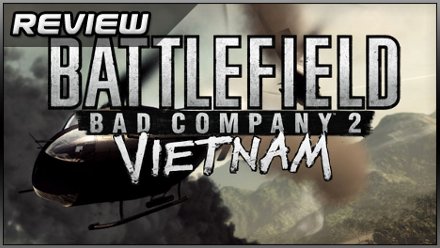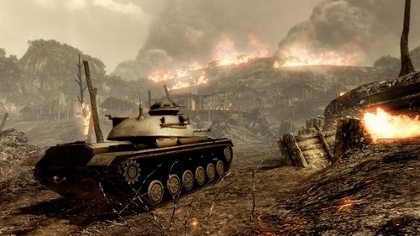
Every major modern war has its own particular cultural residue, but perhaps no other is so laden with connotations today as the Vietnam War – a spicy melange of superpower hubris, racial atrocity and misinformation served up in a sauce of opulent cinematography and sizzling drug rock.
It’s a body of materials videogame developers have failed, by and large, to translate into a compelling action property, and if the spotlights are back on this Christmas thanks to the efforts of Treyarch and DICE, we’re still waiting for that stroke of genius.
Where Call of Duty: Black Ops shied away from context and commentary during its rapid-cut traipse through the 1960s and ’70s, Battlefield Bad Company 2: Vietnam disdains narrative entirely. It’s just a map pack – a solid map pack at heart, to be sure, well worth the £10/$15/1200 MSP asking price, but not a product that really needs or deserves to be sold as a Vietnam game.
Memorabilia isn’t in short supply. Mission briefings overlay scratchy shots of ink and paper maps, complete with importantly pointing arrows and pipe-smoking newscast, and there are 49 old ‘Nam favourites to listen to via in-game radio. If you’re rocking a Huey, by all means crank up the Wagner – music to pound tanks by.
Tonally, Bad Company’s rogueish, Kelly’s-Heroes-inspired view of war seems to fit Vietnam better than Call of Duty’s utterly humourless machismo, and the slower, broader-based multiplayer style makes more sense here too. The pack’s five maps (Operation Hastings will unlock once a usage milestone has been passed) are as expansive as their cousins in the main game. The hazy jungle vibe doesn’t change much from one to another, but the devil is very definitely in the detail.
Any Bad Company match type can be played on any map, with the Americans always appearing as Attackers. In terms of jaw-drop potential the chef’s choice is Hill 137, which sees US forces grinding the Viet Cong back from a pristine bay to devastated lower slopes, jets swooping decoratively in and out of the smoke pall that boils over the summit.
It’s one of the more linear environments, notwithstanding the option to flank positions near the US foothold by patrol boat, and thus a sound pick for Rush, in which one team must defend pairs of M-com stations from destruction. Two of the stations are positioned a scant 20 metres apart, separated by sand bags, contracting the battle to a bloody focus as a resolution looms.
Flame-throwers, the most obvious of the 15 new contemporary weapons, prove invaluable when it comes to storming the tunnels around the VC base. Even if you escape incineration, it’s hard to counter-attack through a curtain of fire.
Operation Hastings and Phu-Bai Valley are relatively open-ended. The latter offers the most level country, a sweep of water-logged paddy field providing speedy access to the north-east. The former is a sprawl of hills, lagoons and buildings, interlinked by dirt tracks and presided over by a central elevated road that cuts almost the width of the map. Resilient stone temples house some of the flagpoints and M-com stations, while others squat less helpfully in village squares.
There are few surprises among the six new vehicles, save perhaps for the Tuk-tuk, a dinky VC tricycle with the lifespan of a mayfly. Stepping into the stirrups of an M48 Patton tank or M151 MUTT jeep may tickle if you have a taste for military history, but once the buzz fades, you’ll find yourself fighting much as you would aboard any of the franchise’s latter-day equivalents.
Not that that’s such a bad thing, as the BC2 mix of vehicle combat, terrain destruction and specialised infantry classes remains top-tier fodder. Classes retain their old strengths and weaknesses, and reducing parts of the scenery to skeletons of smouldering ash (don’t worry, they had access to grenade launchers during the Tet Offensive) is as gratifying as it is expedient. The contemporary automatic rifles and light machine guns, including M16A1s, M14s and AK47s, settle in nicely and are well-modeled to boot.
Still, an opportunity has been missed. EA has the resources, and DICE has the talent, to put together a fantastic Vietnam game, one that delves rather deeper into the setting than weapon rosters and track lists. Instead, the pair have treated Vietnam as a Flavour of the Month. I can’t fault any of the design calls here – fans of BC2 should opt in without pause – but I can fault the short-term thinking behind them.

Confused? Abused? Eat scoring guide, bitch.






 Satoru Iwata Video Interview - the late Nintendo president spoke with Kikizo in 2004 as 'Nintendo Revolution' loomed.
Satoru Iwata Video Interview - the late Nintendo president spoke with Kikizo in 2004 as 'Nintendo Revolution' loomed. Kaz Hirai Video Interview - the first of Kikizo's interviews with the man who went on to become global head of Sony.
Kaz Hirai Video Interview - the first of Kikizo's interviews with the man who went on to become global head of Sony. Ed Fries Video Interview - one of Xbox's founders discusses an epic journey from Excel to Xbox.
Ed Fries Video Interview - one of Xbox's founders discusses an epic journey from Excel to Xbox. Yu Suzuki, the Kikizo Interview - we spend time with one of gaming's most revered creators.
Yu Suzuki, the Kikizo Interview - we spend time with one of gaming's most revered creators. Tetris - The Making of an Icon: Alexey Pajitnov and Henk Rogers reveal the fascinating story behind Tetris
Tetris - The Making of an Icon: Alexey Pajitnov and Henk Rogers reveal the fascinating story behind Tetris Rare founders, Chris and Tim Stamper - their only interview? Genuinely 'rare' sit down with founders of the legendary studio.
Rare founders, Chris and Tim Stamper - their only interview? Genuinely 'rare' sit down with founders of the legendary studio. The History of First-Person Shooters - a retrospective, from Maze War to Modern Warfare
The History of First-Person Shooters - a retrospective, from Maze War to Modern Warfare
“Opportunity missed”? I strongly disagree. Perhaps someday, a designer will create a Vietnam magnum opus, with all of the subtle and overt political/sociological/historical implications explored.
Remember the Smithsonian’s Enola Gay exhibition? Is that really the “Sweet Spot” for the 360? Nah…
This is a fun, immersive FPS and a good value on top of a great game. Why complicate it? Watch “Hearts and Minds” for real drama; otherwise, shut up and make with the flamethrower!
Wow…
There are other ways to approach Vietnam other than boring history exhibits…
Like what Modern Warfare 2 did with the airport scene, DICE could have done with My Lai.
If we don’t give gaming more depth other than “TORCH COMMUNISTS WITH FLAMETHROWERS”, then it won’t be treated as an art form, and therefore would be subjugated to regulations and censorship by the government since it would be just a form of entertainment. We can see it happening in California today. If gaming doesn’t do anything controversial soon to push the industry forward, we might see more government intervention/bullying in the gaming industry.